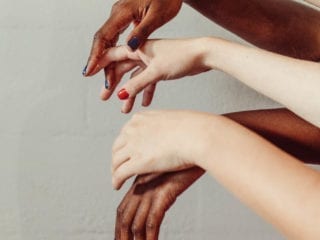August 26 is Women’s Equality Day, a celebration of the passing of the 19th Amendment, which gave American women the right to vote. This landmark day in history was the culmination of a 72-year campaign for equal rights for women. This meant that women would no longer be treated as second-class citizens and would enjoy the “full rights and privileges—public or private, legal or institutional—which are available to men.”
The irony about writing about Women’s Equality Day is that I’ve often taken my right to vote for granted. I’ve always considered having a voice in choosing my leaders to be “natural” or “just the way it is.” When I was a child, I looked forward to exercising my right to vote after turning 18 like I looked forward to any other birthday present.
Younger me didn’t understand the years of campaigning, petitioning, protesting and even risking their own lives that previous generations of women endured to win that right. In honor of this day, let’s look back on the path to women’s suffrage and consider what work for justice and equality remains.
1776: The Issuing of The Declaration of Independence
While the birth of our country brought freedom from British rule, it did not bring true freedom for all U.S. citizens. In the early days of our nation, single women, known as “femes soles” or “women alone,” legally had a number of rights. They could live where they wanted, work in jobs that were not restricted to men, enter into contracts, buy and sell real estate and accumulate personal property. Once a woman married, however, she lost all autonomy. As written in “Commentaries on English Law,” “the very being or legal existence of the woman is suspended during the marriage, or at least is incorporated and consolidated into that of the husband.”
While the birth of our country brought freedom from British rule, it did not bring true freedom for all U.S. citizens.
Nowomen, single or married, had legal rights to inherit. Instead the law followed a custom known as primogeniture, which favored the eldest son of a family for an inheritance. In addition, coverture, the custom of married women forfeiting their rights to their husband’s assets, also still existed. All personal property that a woman brought to a marriage or earned while married belonged to her husband
Abigail Adams was deeply concerned by coverture. She wrote to her husband, former President John Adams, on March 31, 1776, roughly two months before the Constitution was ratified, urging him to remember women.
“Do not put such unlimited power into the hands of the husbands. Remember, all men would be tyrants if they could. If particular care and attention is not paid to the ladies, we are determined to foment a rebellion, and will not hold ourselves bound by any laws in which we have no voice or representation.”
The first version of the Constitution did not, in fact, remember women the way Abigail Adams may have hoped. In the next few decades, the treatment of women as second class citizens would only worsen.
The early 1800s: Voting Rights for White Men
After the Revolutionary War (1775-83), most states retained some property requirements, which inhibited poor people from voting under the notion that a wise vote could only be cast by people who had an economic stake in society. The property requirement for voting was abolished for white men soon after the Revolution. This allowed even poor white men to vote, and by 1840, more than 90 percent of adult white men had the right to vote.
State legislatures strategically used these new laws as an opportunity to restrict women and Black men from voting. The increased push for white male suffrage only reinforced race and gender discrimination. For example, in 1807, New Jersey’s state constitution abolished property requirements while preventing women and free Blacks from voting. Also, in 1821, the New York state legislature extended the right to vote to almost all white men while simultaneously creating high property requirements for free Blacks.
1869: The Founding of the National Woman Suffrage Association
Women did not stop fighting for the right to vote. In 1869, the National Woman Suffrage Association (NWSA) was founded by Susan B. Anthony and Elizabeth Cady Stanton. At the same time, another competing women’s suffrage organization was founded at the same time, the American Woman Suffrage Association (AWSA).
The key differences between these two groups were their positions on the 15th Amendment, which would prohibit denying the right to vote based on race. Anthony and Stanton opposed the amendment, claiming that enfranchising all men would stifle women’s rights further. They believed that women’s rights activists should place a priority on women, instead of supporting the 15th Amendment (and thus the right of Black men to vote).
The AWSA supported it, although one of it’s most prominent leaders, Lucy Stone, was more in favor of suffrage for women than suffrage for Black men. At this time there were many Black suffragists who worked with organizations and experienced racism from white suffragists.
1920: The Passing of the 19th Amendment
In 1920, after decades of campaigning by women’s suffragists—countless marches, petitions and displays of civil disobedience—the 19th amendment was passed.
After decades of campaigning by women’s suffragists—countless marches, petitions and displays of civil disobedience—the 19th amendment was passed.
The text reads, “The right of citizens of the United States to vote shall not be denied or abridged by the United States or by any State on account of sex….Congress shall have power to enforce this article by appropriate legislation.”
Even with the passing of the 19th Amendment, women still faced obstacles to voting. The Constitution in 1920 mandated a minimum voting age of 21, meaning that only women 21 and over could vote. In addition, the voting rights of Black women were restricted by restrictive laws in the South that included poll taxes and literacy tests. At this time, 80 percent of Black citizens lived in the southern states.
In 1924, the Indian Citizenship Act passed, granting Native American women the right to vote (although it was not fully extended until 1957). In the 1940s and 50s, restrictions barring Asian American women from the right to vote were removed.
1965: The Voting Rights Act of 1965
Finally, in 1965, the Voting Rights Act was passed, which broke down state barriers and allowed all Black women the right to vote. Before this act was passed, many states stifled the voting rights of Black people by creating “literacy tests,” or asking Black people to recite the entire Constitution before voting. Even Black men and women with college degrees were turned away. On March 7, 1965, Black activists were attacked by police during a peaceful march for voting rights. The incident was broadcast on national television and created an uproar. The Voting Rights Act was passed a week later.
Today, there is still work to be done. On American soil, Black voters, including women, face barriers to voting such as long wait times, limitations on registering to vote, removal from voter rolls and lost mail-in ballots. It is clear that the conversation on universal suffrage is not confined to history as it still affects our world today.
What have you learned about the women’s suffrage movement? In what ways are women still fighting for equity today?
Image via Ben Cope, Darling Issue No. 19











